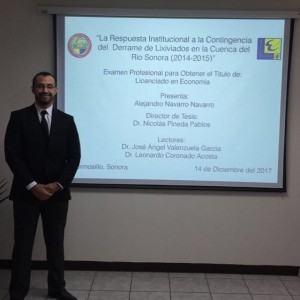Alejandro Navarro
The enterprise “Buenavista del Cobre”, located on the outskirts of Cananea in northern Mexico, is a giant open-pit copper mine that has been operating for more than a century. The town is split up by the watersheds of two rivers, the Sonora and the San Pedro (this is a branch of the Colorado river). On August 6th, 2014, a tailing pond breached, releasing 40,000 m3 of copper sulphate into a tributary of the Sonoran river. The spill polluted “arroyo Tinajas” (17.6 km), Bacanuchi river (64 km) and the main stream of the Sonoran river (190 km); these streams cross over seven municipalities inhabited by 20,048 people. The pollution led the government to close 322 wells leaving local communities without water for domestic and farming uses.
The objective of this study was to analyze the institutional response from local, state, and federal government, intended to solve remediate the problems, struggles, risks or economic losses caused by the pollution. This paper started with the hypothesis of institutional failure defined as lack of institutional capacity for deal with some problem.
The institutional response was tracked down following local newspaper notes related with actions implemented by social actors involved and trying to solve problem. The study identified the response framework set by the federal government and was compared with the currently national framework to deal with natural disasters (SINAPROC). Thar has proved to work well and coordinated different scale government. The study found that instead of following this framework the federal government chose to override the state and municipal governments. This led to implement action and policies within a framework characterized by asymmetric information and higher transaction cost that resulted in a poor and ineffective response.
Therefore, the conclusion was that there was an institutional failure because the government chose to carry out the remediation actions through the CONAGUA, a highly centralized federal agency, instead of improving the governance response through collaborative networks with local authorities and civil society organizations.

